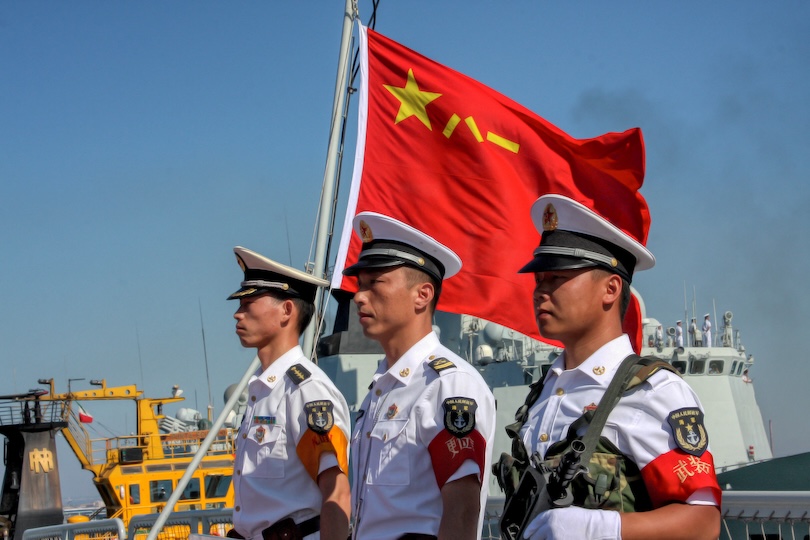Over the previous 20 years, China has emerged as a world financial powerhouse, present process a metamorphosis that extends past its financial energy. China’s pursuit of improved navy capabilities, particularly within the space of deep-sea naval projection, has been equally notable. This growth of China’s naval power-projection capabilities, whereas not stunning from a practical perspective, has raised profound questions in regards to the nation’s true intentions and the ensuing implications for international maritime safety. This evaluation takes a better have a look at China’s naval ambitions, the strategic implications of its elevated maritime place within the South China Sea, and the broader context of Sino-US strategic competitors within the maritime area. As of 2023, the safety panorama within the South China Sea reveals relative stability, with a decreased danger of intensified navy confrontations and escalation. Nonetheless, China’s shift in strategic focus from the South China Sea to the Taiwan Strait underlines the numerous implications of China’s naval energy in distant seas for the prevailing international maritime safety order. It’s vital to grasp that Taiwan, from Beijing’s perspective, is taken into account an inner sovereignty situation, not an exterior flashpoint in worldwide relations.
The present scenario within the South China Sea is of low danger standing. Whereas China and the ASEAN international locations, particularly the claimant international locations, have expressed their need to take care of peace within the South China Sea, basic variations in maritime pursuits and safety insurance policies between the international locations concerned stay. Diplomatic frictions between international locations over the difficulty of the South China Sea proceed to come up, as do the insurance policies and actions of the US, Japan, Australia and different extraterritorial international locations within the South China Sea. As well as, small-scale incidents between maritime forces and legislation enforcement forces, together with coast guards, happen sporadically. These unstable elements affecting the safety scenario within the South China Sea may result in new harmful incidents at sea and within the air, and even escalate into armed battle or navy confrontations.
China’s financial rise and concurrent naval growth are nothing in need of extraordinary, positioning the nation as a formidable participant in international land and maritime safety. Because the world’s second largest financial system, it’s logical that China would need to strengthen its navy capabilities in step with its international standing. From a practical perspective, international locations act in their very own self-interest, and a strong navy is seen as important to securing these pursuits. China’s substantial investments in its navy are emblematic of its ambitions to guard maritime pursuits, safe essential sea lanes and set up itself as a serious maritime energy.
This naval build-up consists of the event of plane carriers, trendy submarines, superior floor combatants and the fast growth of the naval aviation department. These developments transcend regional naval growth and sign China’s emergence as a world participant in maritime energy projection. To guard and defend China’s financial system and safety in Indian Ocean waters, blue water capabilities will assist the brand new international maritime attain within the medium and long run. In consequence, China’s navy attain now extends past its rapid borders, creating the potential to affect and reshape the worldwide maritime safety order.
Understanding China’s naval intentions is important in evaluating its affect on international maritime safety. Remarkably, since its final typical warfare in 1979, China has avoided large-scale navy battle, opting as an alternative for smaller-scale confrontations and standoffs. This sample of habits provides complexity to the interpretation of Chinese language naval intentions, particularly within the software of its offensive naval warfare capabilities in blue-water situations.
The anomaly surrounding the extent to which China intends to increase its affect and management within the South China Sea stays a priority amongst maritime safety stakeholders. Though China makes territorial claims based mostly on historic references, its actions, reminiscent of the development of synthetic islands and navy installations in disputed areas, increase doubts about its dedication to peaceable coexistence and adherence to worldwide norms established and framed beneath the presence of the US Navy. This ambiguity produces complicated indicators about potential escalations and conflicts within the area. On the identical time, america has performed an important position in shaping the present international maritime safety order. The ahead deployment of naval technique, particularly within the South China Sea and the Taiwan Strait, serves not solely to reassure regional allies of Washington’s safety commitments but additionally to counterbalance China’s growth of naval projection capabilities within the distant seas.
The improved place of Chinese language naval energy within the South China Sea has profound strategic implications. This area has considerable pure assets and serves as an important artery for international commerce, with greater than $3 trillion price of products flowing by its waters yearly. China’s rising assertiveness on this space will increase the chance of maritime incidents, accidents and conflicts that would disrupt the worldwide provide chain and trigger financial instability. Furthermore, Chinese language actions within the South China Sea have led to a strategic realignment within the Indo-Pacific area. In response to China’s rising presence, america has strengthened its alliances and partnerships within the area and deployed a ahead maritime technique to take care of its affect and make sure the safety of its allies. Chinese language educational Hu Bo has characterised the evolution of US South China Sea coverage: from non-interference within the Sixties and Nineteen Nineties, to restricted interference from the late Nineteen Nineties to the early 2000s, and direct intervention from the 2010s. This dynamic has fostered a posh net of navy alliances and strategic partnerships, rising the chance of unintended escalations.
For instance, america performs an important position within the South China Sea disputes between China and the Philippines, as underlined by current developments. In September 2023, the Philippine Coast Guard’s decided efforts to take away China’s floating limitations at Scarborough Shoal replicate ongoing tensions within the area. The US has publicly praised the Philippines for its “daring step” in asserting its rights and unequivocally reaffirmed its safety obligations to the nation. The US place is aimed toward sustaining its essential position as a significant component within the ongoing bilateral disputes between China and the Philippines. Manila is strategically utilizing its standing as a claimant state in these territorial disputes with Beijing as a bargaining chip to additional its objectives in its relationship with Washington.
Whereas the South China Sea stays a key focus, current developments underscore a shift in strategic focus to the Taiwan Strait. The Taiwan situation has lengthy been a controversial component in China-US relations, with China viewing Taiwan as a renegade province and america dedicated to supporting safety and autonomy. China’s navy operations within the Taiwan Strait, typically characterised as grey zone techniques, contain unconventional navy actions aimed toward undermining Taiwan’s sovereignty and testing the resolve of america given its refusal to Beijing to acknowledge Taiwan’s sovereignty. These actions embody airspace incursions, cyber assaults and naval workouts performed in shut proximity to Taiwan. Taiwan’s strategic significance, each as a possible flashpoint and as a logo of U.S. dedication to the area, can’t be overstated. Resolving the Taiwan downside is of paramount significance to Beijing and symbolizes an necessary step towards its imaginative and prescient of nice rejuvenation and ending a century of humiliation, affirming China’s standing as a world superpower.
In mild of those developments, the worldwide group ought to fastidiously observe and objectively interpret Chinese language naval intentions and actions. Regardless of the strengthening of China’s naval capabilities and its assertive maritime presence, it’s notable that China has not engaged in typical warfare since 1979. Due to this fact, whereas China’s rise as a world energy is simple, it’s doubtless that Beijing will proceed to stick to worldwide norms. maritime security requirements and rules. Dialogue and diplomacy should stay central to addressing disputes within the South China Sea and the Taiwan Strait, and stopping potential conflicts that would have far-reaching penalties.
Whereas questions have been raised and considerations have been raised about what may occur over the Taiwan Strait and whether or not incidents may escalate into direct navy confrontations or naval wars between China and america, the possibilities of escalating friction within the South China Sea a focus for potential escalation of the navy confrontation. The US, as a longstanding maritime energy, faces the fragile activity of balancing its dedication to the safety of its allies with the necessity to keep away from direct confrontation with China. A well-considered strategy that mixes deterrence, diplomacy and dedication to regional stability is indispensable.
In conclusion, China’s burgeoning capabilities for projecting energy at sea are a logical consequence of its rise as a world financial juggernaut. However, these developments increase vital strategic considerations within the South China Sea and the Taiwan Strait, that are vital to the continued strategic competitors between China and the US. The worldwide group ought to diligently observe and interpret China’s actions, promote peaceable decision of disputes, and work collectively to take care of the steadiness of the worldwide maritime safety order. The stakes are vital, and the world can not afford to underestimate the results of mismanaged tensions in these important maritime areas.
Learn extra about e-international relations

